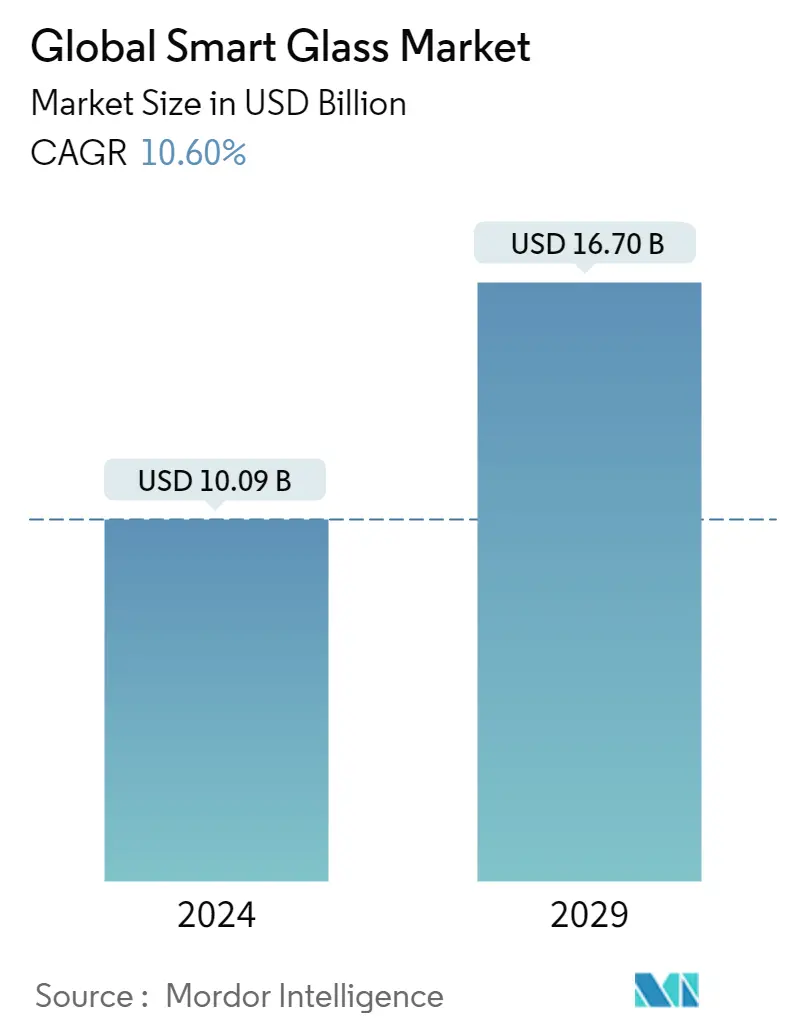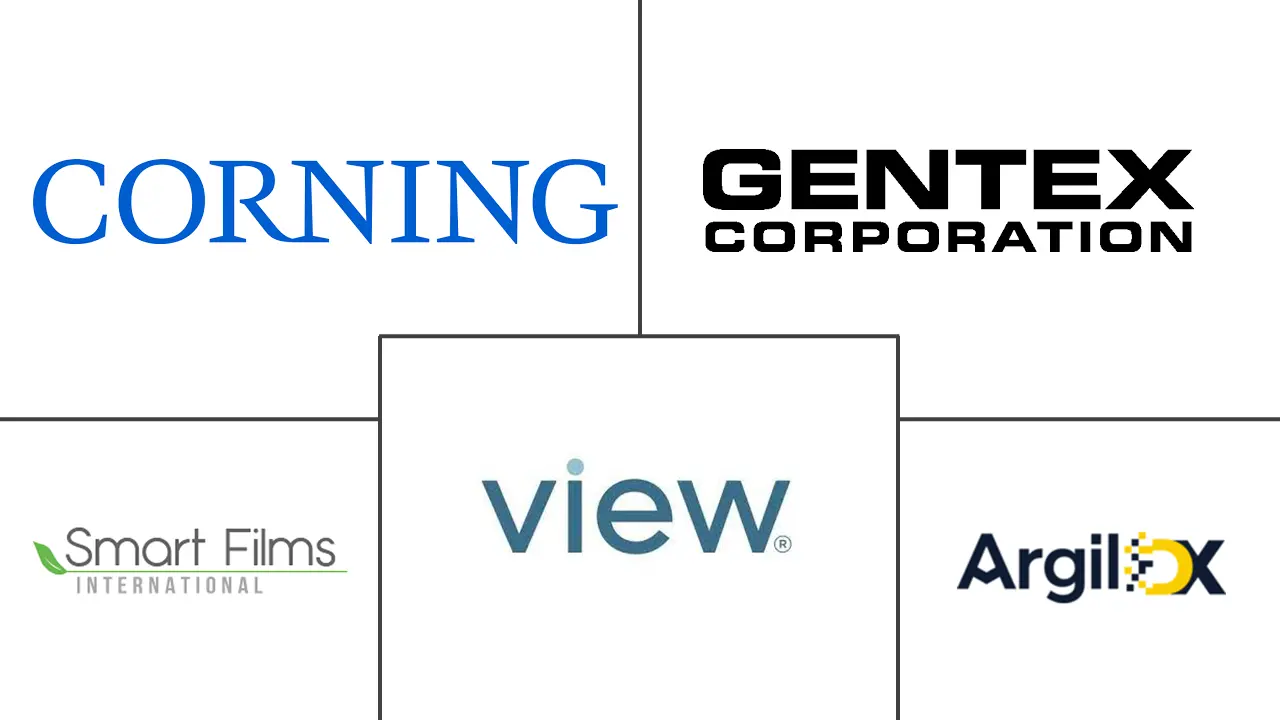Market Size of Global Smart Glass Industry

| Study Period | 2019 - 2029 |
| Market Size (2024) | USD 10.09 Billion |
| Market Size (2029) | USD 16.70 Billion |
| CAGR (2024 - 2029) | 10.60 % |
| Fastest Growing Market | Europe |
| Largest Market | North America |
Major Players
*Disclaimer: Major Players sorted in no particular order |
Smart Glass Market Analysis
The Global Smart Glass Market size is estimated at USD 10.09 billion in 2024, and is expected to reach USD 16.70 billion by 2029, growing at a CAGR of 10.60% during the forecast period (2024-2029).
The market has been gaining significant traction due to the surging demand for energy cost savings in high-end commercial offices and residential spaces. With a growing focus on sustainable development, many people have been opting for user-controlled windows in buildings. Smart glass manufacturers have been actively investing in research and development to cut production costs by implementing newer technologies and low-cost raw materials.
- Smart glass has applications in many end-user verticals, owing to its unique properties. However, only the applications encountered in the construction sector and transportation industries stand to be a high source of demand for smart glass in the current market scenario. The increasing regulatory reforms, such as the National Green Building Standard, Green Globes, LEEDS, etc., enable commercial building owners to spend on smart energy-saving solutions, such as smart glass.
- In December 2021, Halio, builder of technologically advanced smart windows, exhibited an electrochromic glass solution in the "Green Avenue" section of the SK CES 2022 booth located in the Las Vegas Convention Center, Central Hall. The glass solution addressed the ten must-haves for architects, developers, and environmentalists as they formulate strategies to achieve net zero buildings. The advanced smart glass is the first to address critical design and performance issues, including clear and tint color, responsiveness and speed, tint uniformity, and cloud-based artificial intelligence (AI) for autonomous operation. Halio's AI determines the maximum amount of daylight that can enter the building in real-time to deliver energy savings that reduce carbon emissions by up to 20%, aiding in staving off global warming while minimizing glare management that leads to occupant wellness.
- Boing and Airbus, aerospace application companies, have been deploying smart glass technology by integrating IoT systems. For instance, Boeing 787 Dreamliner airplane features electrochromic windows, which turn entirely opaque with a button's click. This trend has been obtaining popularity among all the luxury and private jet manufacturers globally, opening new market opportunities.
- Besides aerospace, smart glass is increasingly being adopted in ships and trains. For instance, recently, Vision Systems exhibited a wide variety of SPD-SmartGlass products designed for the cruise industry to improve the cruise ship passenger experience.
- Moreover, several key federal policy directives, rising energy costs, and stringent regulations concerning greenhouse gas emissions are significant factors driving energy-efficient measures. Therefore, the countries have been increasingly optimizing the use of renewable energy sources.
- However, the outbreak of the COVID-19 pandemic has caused disruptions in the smart glass market. The market studied was highly affected due to decreased construction activities and supply chain disruptions. The outbreak of the COVID-19 pandemic has significantly affected the construction activities of residential and commercial buildings in 2020 and has resulted in building construction projects being delayed or halted in the short term. The demand for construction projects has fallen owing to poor business sentiments, lower operating surpluses and incomes, diversion of funds for COVID-19 management, and liquidity problems.
- According to the European construction forecasting body Euroconstruct, the European construction market is expected to shrink by 7.8% this year and will not recover fully until 2023, with forecast growth of 4.1% in 2021, 3.4% in 2022, and 2.4% in 2023. With such a decline in construction activities, the demand for smart glass is anticipated to decrease.
Smart Glass Industry Segmentation
Smart glass is defined as a class of electrically active glass that enables the creation of 'intelligent partitions' within a particular area. These glasses are currently being deployed in key applications such as construction, automotive, and aviation industry to enable active control of light within a medium. The Smart Glass Market is segmented by Type (Electrochromic, Suspended Particle Device (SPD), Liquid Crystal, Passive), End - User (Automotive, Architectural, Avionics), and Geography.
| By Type | |
| Electrochromic | |
| Suspended Particle Device (SPD) | |
| Liquid Crystal | |
| Passive (Thermochromic & Photochromic) | |
| Other Types (Hybrid, Photovoltaic) |
| By End User | |
| Automotive | |
| Architectural (Residential & Commercial Buildings) | |
| Avionics | |
| Other End Users |
| By Geography | |
| Americas | |
| Asia Pacific | |
| Europe, Middle East & Africa |
Global Smart Glass Market Size Summary
The smart glass market is experiencing robust growth, driven by increasing demand for energy-efficient solutions in both commercial and residential sectors. This growth is fueled by a heightened focus on sustainable development and the adoption of user-controlled windows, which offer significant energy cost savings. Manufacturers are investing heavily in research and development to innovate and reduce production costs through advanced technologies and cost-effective raw materials. The market is witnessing substantial applications in the construction and transportation industries, with regulatory reforms like the National Green Building Standard and LEEDS encouraging the use of smart glass as an energy-saving solution. The technology's unique properties are being leveraged in various sectors, including aerospace, where companies like Boeing and Airbus are integrating smart glass with IoT systems to enhance passenger experiences.
Despite the promising growth trajectory, the smart glass market faced challenges due to the COVID-19 pandemic, which disrupted construction activities and supply chains, leading to a temporary decline in demand. However, the market is rebounding, with increasing adoption in the automotive industry, where smart glass is used in sunroofs and dimming rear-view mirrors, and in transportation sectors such as trains and ships. The commercial sector is also seeing a rise in smart glass applications, with its aesthetic and energy-saving benefits being recognized in office spaces and public buildings. Key players in the market, including View Inc., Corning Incorporated, and Gentex Corporation, are actively expanding their offerings and leveraging strategic acquisitions to strengthen their market position. As energy costs rise and environmental regulations tighten, the demand for smart glass is expected to continue its upward trend, offering significant opportunities for growth across various industries.
Global Smart Glass Market Size - Table of Contents
-
1. MARKET DYNAMICS
-
1.1 Market Overview
-
1.2 Market Drivers
-
1.2.1 Increasing Energy Efficiency Regulations and Need for Energy Cost Savings
-
1.2.2 Increasing Preference for Comfort, Convenience and Green Credentials
-
-
1.3 Market Restraints
-
1.3.1 High Cost and Competition from Flexible Plastic Technologies
-
-
1.4 Industry Attractiveness - Porter's Five Forces Analysis
-
1.4.1 Bargaining Power of Suppliers
-
1.4.2 Bargaining Power of Buyers
-
1.4.3 Threat of New Entrants
-
1.4.4 Threat of Substitute Products
-
1.4.5 Competitive Rivalry
-
-
1.5 Impact of COVID-19 on the Industry
-
-
2. MARKET SEGMENTATION
-
2.1 By Type
-
2.1.1 Electrochromic
-
2.1.2 Suspended Particle Device (SPD)
-
2.1.3 Liquid Crystal
-
2.1.4 Passive (Thermochromic & Photochromic)
-
2.1.5 Other Types (Hybrid, Photovoltaic)
-
-
2.2 By End User
-
2.2.1 Automotive
-
2.2.2 Architectural (Residential & Commercial Buildings)
-
2.2.3 Avionics
-
2.2.4 Other End Users
-
-
2.3 By Geography
-
2.3.1 Americas
-
2.3.2 Asia Pacific
-
2.3.3 Europe, Middle East & Africa
-
-
Global Smart Glass Market Size FAQs
How big is the Global Smart Glass Market?
The Global Smart Glass Market size is expected to reach USD 10.09 billion in 2024 and grow at a CAGR of 10.60% to reach USD 16.70 billion by 2029.
What is the current Global Smart Glass Market size?
In 2024, the Global Smart Glass Market size is expected to reach USD 10.09 billion.

